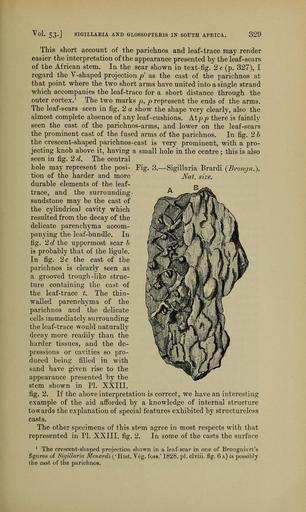MAKE A MEME
View Large Image

| View Original: | The_Quarterly_journal_of_the_Geological_Society_of_London_(12893979654).jpg (1220x2042) | |||
| Download: | Original | Medium | Small | Thumb |
| Courtesy of: | commons.wikimedia.org | More Like This | ||
| Keywords: The Quarterly journal of the Geological Society of London (12893979654).jpg Vol 53 J SIOILLAKIA AND GLOSSOPTER1S IN SOUTH AFEICA <br> 329 <br> This short account of the parichnos and leaf-trace may render <br> easier the interpretation of the appearance presented by the leaf-scars <br> of the African stem In the scar shown in text-fig 2 e p 327 I <br> regard the V-shaped projection p' as the cast of the parichnos at <br> that point where the two short arms have united into a single strand <br> which accompanies the leaf-trace for a short distance through the <br> outer cortex 1 The two marks p p represent the ends of the arms <br> The leaf-scars seen in fig 2 a show the shape very clearly also the <br> almost complete absence of any leaf- cushions Atpp there is faintly <br> seen the cast of the parichnos-arms and lower on the leaf-scars <br> the prominent cast of the fused arms of the parichnos In fig 2 b <br> the crescent-shaped parichnos-cast is very prominent with a pro- <br> jecting knob above it having a small hole in the centre ; this is also <br> seen in fig 2 d The central <br> hole may represent the posi- Fig 3 ” Sigillaria Brardi Brongn <br> tion of the harder and more Nat size <br> durable elements of the leaf- <br> trace and the surrounding- <br> sandstone may be the cast of <br> the cylindrical cavity which <br> resulted from the decay of the <br> delicate parenchyma accom- <br> panying the leaf-bundle In <br> fig 2d the uppermost scar b <br> is probably that of the ligule <br> In fig 2 c the cast of the <br> parichnos is clearly seen as <br> a grooved trough -like struc- <br> ture containing the cast of <br> the leaf-trace t The thin- <br> walled parenchyma of the <br> parichnos and the delicate <br> cells immediately surrounding <br> the leaf-trace would naturally <br> decay more readily than the <br> harder tissues and the de- <br> pressions or cavities so pro- <br> duced being filled in with <br> sand have given rise to the <br> appearance presented by the <br> stem shown in PI XXIII <br> fig 2 If the above interpretation is correct we have an interesting <br> example of the aid afforded by a knowledge of internal structure <br> towards the explanation of special features exhibited by structureless <br> casts <br> The other specimens of this st m agree in most respects with that <br> represented in PL XXIII fig 2 In some of the casts the surface <br> 1 The crescent- sli aped projection shown in a leaf-scar in one of Brongniart's <br> figures of Sigillaria Menardi 'Hist Veg fuss ' 1828 pi clviii fig 6 a is possibly <br> the cast of the parichnos 36029126 111130 51125 Page 329 Text 53 http //www biodiversitylibrary org/page/36029126 1897 Geological Society of London NameFound Sigillaria NameConfirmed Sigillaria EOLID 13132168 NameBankID 4343184 Biodiversity Heritage Library The Quarterly journal of the Geological Society of London v 53 1897 Geology Periodicals Smithsonian Libraries bhl page 36029126 dc identifier http //biodiversitylibrary org/page/36029126 smithsonian libraries Information field Flickr posted date ISOdate 2014-03-03 Check categories 2015 August 26 CC-BY-2 0 BioDivLibrary https //flickr com/photos/61021753 N02/12893979654 2015-08-26 17 57 52 cc-by-2 0 PD-old-70-1923 The Quarterly journal of the Geological Society of London 1897 Photos uploaded from Flickr by Fæ using a script | ||||